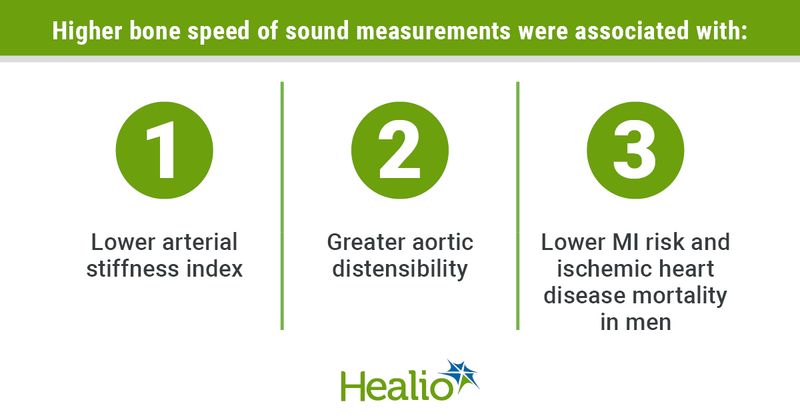Good bone quality linked to better CV health for UK adults
Participants in the UK Biobank who had a higher bone speed of sound were more likely to have good cardiovascular health, according to a study published in The Journal of Bone and Mineral Research.
“Cardiovascular disease, in particular, ischemic heart disease, is an important global cause of morbidity and mortality. Osteoporosis is a growing public health problem, particularly in aging populations. These two conditions share a number of risk factors, such as older age, sedentary lifestyle and smoking,” Zahra Raisi-Estabragh, MBBS, PhD, a British Heart Foundation clinical research training fellow at Queen Mary University of London, told Healio. “Existing work suggests associations between the two conditions that extend beyond their common risk factors. Furthermore, limited biological studies have suggested potential mechanistic links between the two conditions. Understanding the interplay between ischemic heart disease and osteoporosis may provide insight into novel disease pathways and inform interventional and population health strategies.”

Raisi-Estabragh and colleagues at the MRC Lifecourse Epidemiology Unit (MRC LEU), University of Southampton, and the William Harvey Research Institute, NIHR Barts Biomedical Research Centre, QMU, analyzed data collected in the UK Biobank, a population study conducted among adults aged 40 to 69 years from 2006 to 2010 in the United Kingdom. Researchers collected data from participants who had a calcaneal quantitative ultrasound to measure bone speed of sound, with higher speed of sound values indicating better bone health.
Researchers used three metrics to determine CV health. The arterial stiffness index was calculated at baseline using finger photoplethysmography, with lower values indicating better CV health. Aortic distensibility was assessed with CV MRI, with higher values indicating better CV health. Researchers also compiled the number of incidents of myocardial infarction and ischemic heart disease mortality among participants during a follow-up duration of 7 to 12 years.
Complete bone speed of sound and arterial stiffness index data were available for 71,949 men and 87,593 women (mean age, 58 years; 91.9% white). In a fully adjusted model, higher speed of sound values were associated with lower arterial stiffness index, with similar values found for men and women and for premenopausal and postmenopausal women. Higher speed of sound was associated with greater aortic distensibility in the ascending aorta for women and in the descending aorta for men.
Mediators in the association differed for men and women. For men, alkaline phosphatase accounted for 7.5% of the association, phosphate accounted for 4.6% and vitamin D was responsible for 3.2%. For women, phosphate accounted for 13.2%, whereas alkaline phosphatase accounted for 9.6%. For men, C-reactive protein accounted for 6.1% of the effect, but the effect was reversed for women, accounting for –8.6%. Sex hormone-binding globulin had a similar effect for men (17.14%) and women (19.55%).
In crude models, a higher bone speed of sound was associated with a lower risk for MI and ischemic heart disease mortality in men. In a model adjusted for hypertension, hypercholesterolemia and diabetes, each one standard deviation increase in bone speed of sound was associated with a 14% lower risk for ischemic heart disease mortality for men (subdistribution HR = 0.86; 95% CI, 0.75-1). Women had a much weaker association between higher speed of sound and a lower risk for MI and reduced heart disease morality.
“We demonstrate, in the largest cohort ever studied, that poorer bone health is associated with poorer vascular health as measured by objective and validated methods, whilst accounting for classical cardiovascular risk factors. We also demonstrate the association of poorer bone health with greater risk of ischemic heart disease deaths. These relationships were consistent for men and women and were not modified by menopause status,” Raisi-Estabragh said.
The mechanisms driving the associations are complex and likely vary by sex, Raisi-Estabragh noted.
“The wealth of information available in the UK Biobank permitted a highly detailed analysis of the complex interactions between musculoskeletal and cardiovascular health, helping to elucidate potential underlying mechanisms and informing novel approaches to clinical risk assessment,” Nicholas Harvey, PhD, professor of rheumatology and clinical epidemiology at the MRC LEU, University of Southampton, who supervised the work, told Healio.

